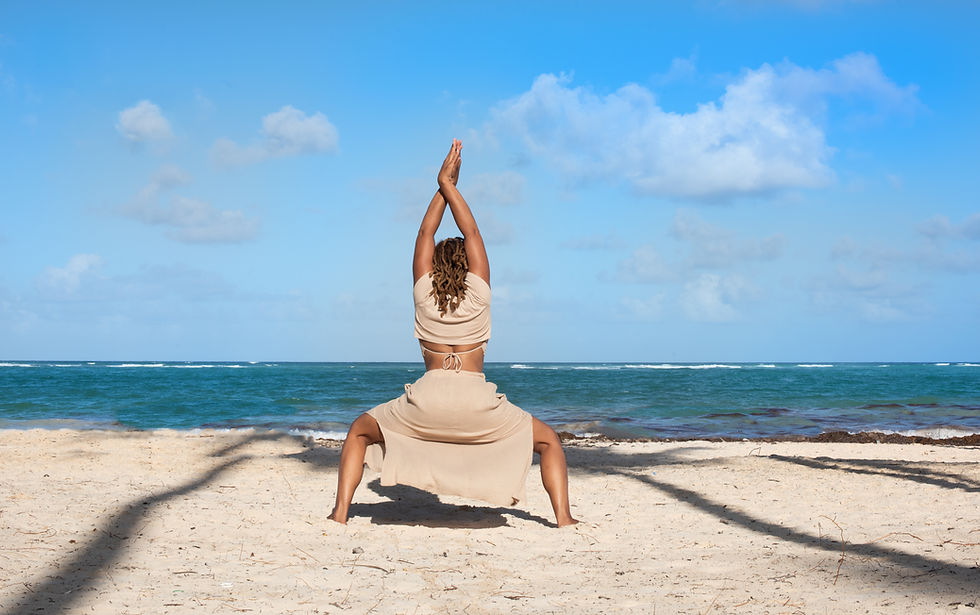I am open to the power of the Goddess radiating from the core of my being, offering strength and nourishment.

Deviasana
Devi = Goddess
Asana =Posture
Devi is the feminine, expanding force the creates the Universe. Manifesting as Mother Nature, wisdom, force, beauty, and wealth.
Energetically, this pose encourages the downward flow of energy, called apana, and activates the lower three chakras.
These are the Root, Sacral, and Solar Plexus chakras which govern our sense of identity, emotional and mental stability, and relationships with the outside world.
Activating these chakras will help you feel more powerful and confident within, more stable and secure, and will also boost your creative and sexual energy.
Goddess Pose Fundamentals
Awaken your inner goddess, challenge your balance and build heat in Goddess Pose.
Both men and women have both a masculine and a feminine aspect within them, and this yoga asana aims to connect us with our feminine energy.
Goddess Pose is a variation of a squat, so expect a challenge for your legs. It simultaneously strengthens and stretches the lower body. The strengthening action allows you to build more stability for other standing positions.
The mighty Hindu goddess Kali is often depicted in this pose. She symbolizes the strength, fierceness, and power of the feminine side of the universe. Simultaneously, she is seen as the goddess of death and destruction, but also as the mother of all beings and the ultimate protector.
The pose puts to the front the more fierce manifestation of the divine feminine. Try practicing with this intention, emulating the power of the goddess Kali, and you will see the impact Goddess Pose has on your confidence.
Since the pose provides a deep opening to the hips, you might also feel a release of emotions, as we tend to store them in this area. Try to observe the emotions, without judgment, and use your breath to release them.
Goddess Pose Benefits
Stretches and opens the hips, groin, chest, and inner thighs.
Strengthens the quads, glutes, psoas muscles, knees, ankles, and hip joints. Having the arms in the cactus position will also strengthen the shoulders, upper back, and arms.
Since there are many alignment cues to think about, this pose may ease overthinking and improve your focus and concentration.
Encouraging you to open your hips, strengthen your lower body and elongate your spine, this pose may help you become aware of your posture which may lead to better postural habits even after the class.
Increases blood flow to the pelvic floor, which may reduce pain in the hips and lower back and relieves menstrual cramps.
Correct alignment, active engagement of the abs, and deep breathing will stimulate the vital organs, respiratory and urogenital systems, and calm the nervous system. These benefits are particularly present when the pose is held for longer.
How To Do Goddess Pose: Step-By-Step
How To Get There:
1. Begin in a standing position with your legs opened wide. Your feet should be around 3 to 4 feet-distance apart.
2. Raise your arms to shoulder height and bend your elbows, so the hands are pointing towards the sky, in the cactus position, palms facing forward.
3. Open your feet out around 45 degrees, so they point towards the corners of your mat.
4. With an exhalation, bend your knees and squat down. Press your hips slightly forward and open the knees wide.
5. Drop your shoulders and open your chest. Keep your arms engaged and gaze to the front, keeping your chin parallel to the ground.
6. Hold the pose for around 3 to 5 breaths, or longer if you feel comfortable.
7. To release, straighten the legs, release the arms to your sides and return to Mountain Pose.
A variety of hand and arm positions may be used for this pose, including raising the arms overhead shoulder-distance apart or with the palms touching. The hands can also be placed in prayer position at the heart center or may rest on the hips or thighs. In another common arm position, the arms extend out at shoulder height and are bent at the elbows so the forearms are vertical, with the palms facing forward and the fingers pointing up.
Tips And Tricks:
One of the biggest challenges in this pose is achieving the proper alignment in the knees. Keep them in line with your toes to ensure they are not moving too much inwards or outwards. Having this in mind will also help you engage your thighs.
If having your arms in Cactus Position is difficult, you can also keep your hands on your thighs or hips, or on your chest in the Prayer Position.
Ideally, your thighs would be parallel to the ground, but if that’s too difficult, you can also raise up in a shallower squat.
If you struggle with balance, practice against a wall, or hold the back of a chair for support.
Remember to keep your spine long throughout the pose, and maintain a smooth and deep breath.
Precautions & Contraindications:
Common misalignments
Knees moving inwards or outwards. Make sure to open the feet slightly to allow your knees to stay in line with the ankles. Adjusting the width of your stance may also help with that.
Arching the lower back. Tuck the pelvis slightly and engage your lower abs to ensure your lower back is straight and in line with the rest of the spine.
Injuries
Avoid the pose if you have an injury in the hips, back, shoulders, legs, or knees.
Comments